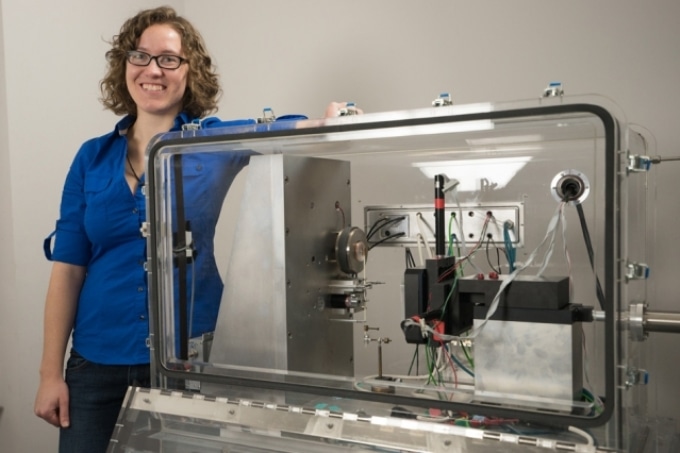May 10 2017
 "The most interesting thing about these materials is they function at temperatures above 500 degrees Celsius," says MIT graduate student Jessica Swallow, pictured with the equipment used for testing the new materials. (Courtesy of the researchers)
"The most interesting thing about these materials is they function at temperatures above 500 degrees Celsius," says MIT graduate student Jessica Swallow, pictured with the equipment used for testing the new materials. (Courtesy of the researchers)
Performing maintenance operations within a nuclear plant puts extreme stress on equipment, due to very high temperatures that are hard for components to withstand without degrading. Recently, some researchers at MIT and elsewhere have developed a radically new approach to create actuators that could be used in such very hot environments.
The system depends on oxide materials comparable to those used in several of today’s rechargeable batteries, in that ions travel in and out of the material while charging and discharging. Whether the ions are oxygen ions, in the case of oxide material batteries, or lithium ions, in the case of lithium ion batteries, their reversible motion results in the material expanding and contracting.
Such expansion and contraction can be a huge issue impacting the operational lifetime of a fuel cell or battery, as the repeated alterations in volume can cause cracks to develop, potentially resulting in degraded performance or short-circuits. But for high-temperature actuators, these volume alterations are a preferred result rather than an unwanted side effect.
The research details are described in a report published this week in the journal Nature Materials, by Jessica Swallow, an MIT graduate student; Krystyn Van Vliet, the Michael (1949) and Sonja Koerner Professor of Materials Science and Engineering; Harry Tuller, professor of materials science and engineering; and five others.
The most interesting thing about these materials is that they function at temperatures above 500 degrees Celsius.
Jessica Swallow, Graduate Student, MIT
That indicates that their predictable bending motions could be harnessed, for instance, for maintenance robotics within a nuclear reactor, or actuators within spacecraft engines or jet engines.
By combining these oxide materials with other materials whose dimensions stay constant, it is possible to create actuators that bend when the oxide contracts or expands. This action is akin to the way bimetallic strips function in thermostats, where heating makes one metal to expand more than another that is bonded to it, causing the bonded strip to bend. For these experiments, the researchers used a compound nicknamed ‘PCO’, for praseodymium-doped cerium oxide.
Conventional materials used to produce motion by using electricity, such as piezoelectric devices, do not function nearly as well at such extreme temperatures, so the new system could pave the way for a new area of high-temperature actuators and sensors. The researchers say such devices could be used, for instance, to open and close valves in these hot environments.
A high-resolution, probe-based mechanical measurement system for high-temperature conditions that Van Vliet and her co-workers had built over the years became helpful in achieving the current finding.
The system provides “precision measurements of material motion that here relate directly to oxygen levels,” she says, allowing the researchers to measure precisely how the oxygen is cycling in and out of the metal oxide.
To conduct these measurements, the researchers start by depositing a thin layer of metal oxide on a substrate, then use the detection system, which can measure small movements on a scale of nanometers, or billionths of a meter. “These materials are special,” she says, “because they ‘breathe’ oxygen in and out, and change volume, and that causes the substrate to bend.”
Though they demonstrated the process using one specific oxide compound, the researchers believe that their theory can be applied to many oxide materials, and even to other kinds of ions over and above oxygen, moving in and out of the oxide layer.
These findings are highly significant, since they demonstrate and explain the chemical expansion of thin films at high temperatures. Such systems show large strain in comparison to other high-temperature stable materials, thereby enabling new applications including high-temperature actuators.
Holger Fritze, Professor, Clausthal University of Technology
“The approach used here is very novel,” says Brian Sheldon, a professor of engineering at Brown University, who also was not involved in this research. “As the authors have pointed out, this approach can provide information that differs from that obtained with other methods that are employed to investigate chemical expansion.”
This research has two key features, Sheldon says: It offers significant basic information about the chemical expansion of such materials, and it paves the way for new kinds of high-temperature actuators. “I think that both are very important accomplishments,” he says.
The study was supported by the U.S. Department of Energy’s Office of Basic Energy Science Small Research Grants Program, and used shared facilities provided by the National Science Foundation’s MRSEC Program.